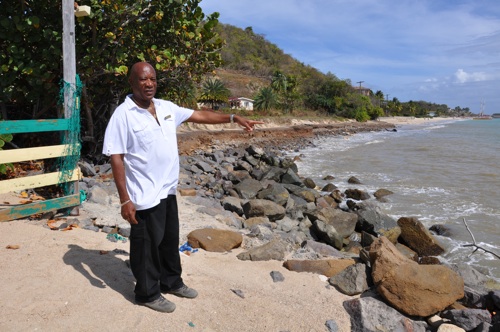Wednesday, April 24, 2024
News and Views from the Global South
In Antigua, Climate Change Amplifies Human Destruction

- Evi Johnson points to the spot where, as a young boy, he and his friends would go swimming at Crabb Hill Beach.
But it is not the white sandy beach he knew as a teenager on Antigua’s southern coast. Even the once turquoise water has turned brown as a result of the silt, forcing Johnson, now in his 60s, to find a new spot for his regular swim.
“I don’t know the reason why this is happening. I just know that there used to be a part of the beach there and it is no longer there,” he told IPS, adding that his favourite spot has disappeared just “in recent times”.
The restaurant where Johnson works is also located on Crabb Hill Beach. Locals and tourists have dubbed it OJ’s Rock Bar because the owners had to put rocks along the shoreline to prevent the building from falling into the sea.
“The water would come all the way up right under the kitchen, and it was undermining the whole structure,” Johnson explained.
Eli Fuller, a marine environmentalist who runs an eco-tour business here, has been observing the erosion of several beaches as he traverses the island. He insists the situation is a result of climate change.
From one man-made phenomenon to another
But what is more troubling, Fuller said, is that many people here, including the government, are blaming climate change for many problems more clearly caused by development and bad environmental and fisheries management.
One such example is beach erosion. “It’s very easy to blame terrible erosion on Dickenson Bay on climate change, but the reality is there are many other factors caused by people here in Antigua that have caused the erosion,” he said.
“If you take a beach that has had poor developmental management and then throw in a barrier reef that has had bad fisheries management, then you can see climate change effects also in a more noticeable way. It’s all quite complex and in a way, easy to be simplified by blaming all the problems on climate change.”
Fuller told IPS that the few beaches around Antigua that have little or no erosion are remote ones that are far from the effects of development.
Of the 365 beaches Antigua prides itself on having, “only about five…are doing well,” Fuller said. “Most beaches in Antigua have had severe erosion over the last 15-20 years.”
A country report on Antigua and Barbuda titled “Planning for Adaptation to Climate Change” pointed out that climate change affects beaches primarily through two processes: sea level rise and increased frequency of high impact weather events, such as hurricanes and tropical storms.
“Sea level rise would result in most cases in a net erosion of the beach by allowing storm waves to strike further inland, and by decreasing the ability of calm waves to rebuild the beach,” noted the report, by the Organisation of American States (OAS).
“In many cases, sea level rise would result in a retreat of beaches, but where natural landforms or human land developments impeded this retreat, net beach erosion would occur,” it added.
Tourism is Antigua and Barbuda’s primary source of foreign exchange, generating approximately 200 to 300 million U.S. dollars annually, or about 65 percent of the nation’s gross domestic product (GDP). For Antigua, like most of the Caribbean, tourism is and continues to be the most important productive sector in its contribution to employment and foreign exchange earnings.
Antigua’s tourism tagline hinges on a popular phrase “the beach is just the beginning”, and the country is still considered a desired vacation destination for visitors from Europe and North American. It is also a preferred cruise port.
Scores of visitors who come here, even for a single day, usually include a visit to the beach as part of their itinerary.
The high costs of erosion
But environmentalist Alan Scholl warns that while many visitors and residents continue to enjoy what’s left of the country’s beautiful beaches, if care is not taken in managing these resources, several of them could severely degrade or disappear altogether.
“While we cannot control the occurrence of natural erosion from tides, ground swells, large waves created by winter storms, and hurricanes, we can minimise human activity that contributes to beach erosion,” he said.
“Construction can affect beach dynamics and lead to exaggerated erosion. When the construction of buildings and, more commonly, of concrete walls places them in the shoreline, the sand cannot shift and is lost to deeper water. When this occurs, it takes years for that sand to return.”
Fuller said when climate change exacerbates problems caused by humans, the consequences can be quite severe.
“When you have, let’s say, stronger storms which theoretically, arguably, are caused by climate change… then you are going to have big problems with beach erosion,” he said.
Climatologist Dale Destin, however, is satisfied with the progress made by Antiguans and Barbudans on climate change awareness and its impact. “I would say that we are more conscious of the issues now than we were five or 10 years ago,” he said.
Destin noted however that while climate change remains an issue of concern to citizens, “Our actions may not be entirely consistent with our knowledge of the issue.”
He said more attention must be given to the ramifications and fallout of climate change “especially given our small size and the possibility of rising sea levels on our vital tourism industry.”

 Print
Print



